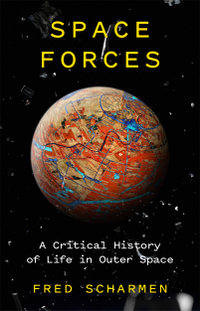New book 'Space Forces' examines the cultural drivers of space exploration
Space exploration doesn't happen in a vacuum.

Space exploration doesn't happen in a vacuum. Instead, our ideas of space exploration are shaped by our cultural contexts, according to architecture and urban design professor Fred Scharmen.
Scharmen grew up obsessed with human spaceflight and has returned to the topic as an architect to explore how ideas about spaceflight are influenced by the hopes and fears and fashions of the culture in which they are developed. He analyzes seven different spaceflight visions spanning 150 years in his new book, "Space Forces: A Critical History of Life in Outer Space" (Verso, 2021). (Read an excerpt from "Space Forces.")
"Space Forces" highlights not just rocket designers and science-fiction authors but also artists and strategists and, of course, today's space billionaires. Space.com sat down with Scharmen to talk about the book. This interview has been edited for length and clarity.
Related: Best space and sci-fi books for 2021
Space Forces: A Critical History of Life in Outer Space | $25.96 from Amazon
Architect and urban designer Fred Scharmen examines seven visions of what living in space could look like and how those ideas are shaped by the cultures they were born into.
Space.com: How did this book come about for you?
Fred Scharmen: Like a lot of people, I've always been interested in space stuff, ever since I was a kid. But when I started to get into architecture more seriously, first as a designer and practitioner, and then later as an academic and teacher, I had the opportunity to go back and sort of interrogate that early obsession that I had as a kid that a lot of us had as kids.
We get caught up in the cool, pretty pictures, and in architecture and urban design, we love making pretty pictures, too. But it's also always worth interrogating those pretty pictures and going, "What's really going on here? Where's this coming from? What's the context? Who is it aimed at?" I got really interested in, like, going deep into some of the renderings that I had grown up with as a child of the '80s ... and so my first book is about those.
Get the Space.com Newsletter
Breaking space news, the latest updates on rocket launches, skywatching events and more!
Coming out of that first book, I realized that there are a lot more stories that could and should be told in the same way. I found all the same kind of weird and interesting connections between like, anxiety, politics, pop culture [and] science fiction 150 years ago. I tried to put these moments into those same kinds of contexts: what's going on in culture, what's going on in science fiction, what's going on in politics? What are people afraid of? What are they hopeful about? And what do these ideas about living in space tell us about what it means to live in a world generally, whether we make that world from scratch out in space or we're producing and making and negotiating with each other in the world we have?

Space.com: How does your background as an architect shape the way you look at space exploration?
Scharmen: The things that I learned about in architecture school, the things that I worked with working in offices and the things that I was trying to teach students, they all come right to the foreground when the question is, how do we make everything? We're out here in nothing, we need space to occupy and live in — what do we want to make? All the stuff we take for granted becomes really fraught because you've got to choose. You've got to choose the composition of the air. If you're spinning for artificial gravity, you've got to decide, do we want to be light and be able to jump around, or do we want to have one gravity [like on Earth] and prioritize health concerns?
Everything becomes a design choice, basically. As architects, we design the air. We do all this stuff all the time, but we kind of forget about what a weird and important decision that is, designing the air, designing the wall, letting in the light, stairs and mobility issues and accessibility — all these things are about who's able to use the space. In space exploration, I found all the same issues, just writ large, with the volume turned up, that I'd been familiar with from another direction.
Space.com: You spend the bulk of the book digging into history — what was the most surprising or telling incident you found during that research?
Scharmen: I really wish I could have gone more into J.D. Bernal's connection with Rosalind Franklin, who was the discoverer of the DNA molecule — they worked together. J.D. Bernal was an English-Irish chemist and scientist who was creating some of these early ideas for, like, let's create a habitat for millions of people that's floating in orbit and they can do science up there and they can expand and live and create a whole culture of their own up there. In his books from the 1940s, he's writing about how genetic modification might be possible. This is before DNA was discovered, and then the person who would later be his colleague was the discoverer of the means by which that kind of thing could happen. I wish I could have had the chance to go more into that coincidence.
And I think I'll never look at a figure like Wernher von Braun the same way again after digging into some of this research. We're used to hearing in basic histories of space science how von Braun was just obsessed and interested in rockets and wanted the chance to make rockets that could go to space, and since he was in Germany, the only chance he had was to go work for Adolf Hitler and the Nazis and create ballistic missiles. And yeah, they were used in World War II, and that's too bad, but then he came to the United States and he converted to Christianity and he became politically active in America and now he's not a Nazi anymore.
I think there are a lot of aspects to von Braun's thinking [that suggest otherwise], especially his proposals when he first came over to the U.S. to use a future space station as a new terror weapon. He was pushing the idea of the space station to the American military on the grounds of that same kind of fear of random death from above that was essential to the V2 rocket that he designed. That was the most powerful aspect of the V2, that uncertainty — you never knew when it was going to come for you or where it was going to land if you were in London during the V2 campaign.
That was his major selling point: this would be a new kind of scare weapon, and it would win a future World War III. It's not just the German Nazi rocket science that von Braun brought over, but it's sort of Nazi methodologies for waging war that he brought over that were essential to his worldview.
Space.com: There's this sentence you write about him that I thought was just so powerful: "What kind of world are you willing to make, or at least tolerate, in order to get the kind of world that you want?"
Scharmen: It was a tough chapter to write, going into the memoirs of Holocaust survivors, people who had survived the workcamps that mass produced the V2s, which he visited several times. It wasn't a situation that he was oblivious to at all. There is, I find, a kind of a tacit acceptance — it's not an explicit acceptance — that this is a necessary period of pain and suffering but we're headed for utopia, that I find in von Braun's worldview.
It comes through in his science fiction, too. Maybe not surprisingly, he was a writer of science fiction on the side as well. In his science-fiction novel, a future united world government after World War III, which is won by the nuclear-armed space station that he convinced the Americans to build, the new goal is to mount this huge expedition to Mars after they discovered that Martians exist. When his people get to Mars, the elder Martians even tell them, "Yes, it's necessary to go through periods of war and suffering and slavery to find peace and to find technical prosperity in the future, and we know that and you're learning those lessons too, you young humans."
That moment in his science-fiction novel is the kind of thing that I picture him thinking about when he's looking out over these tunnels inside a mountain where enslaved people are building his rockets and basically being worked to death. More people died building the V2s than died in the explosions that they caused.
Space.com: I think you must have had the book written before the private spaceflights this year from Blue Origin, Virgin Galactic and SpaceX. What's your perspective on those flights and how does that relate to the stories you tell in the book?
Scharmen: Yeah, it was totally complete before we hit this rapid explosion in private spaceflight. But what I saw in NewSpace generally was this looming image problem that was a disconnect between audiences that they needed to address because they're private operators.
Private spaceflight companies have to speak to investors on the one hand and say, "Oh, no, this is going to be a profit-driven enterprise, we're going to realize the return on investment. It's safe, it's not going to be about risk-taking, or the construction of any new or weird economics or politics." But they have to turn to public audiences and say, "This is breaking new ground, this is a dangerous adventure undertaken on behalf of all humankind, and we're building access to space for everybody."
NASA, like any institution, has its critics but it's probably one of the most beloved brands, one of the most beloved government operations in history. Everybody loves NASA. NASA is so good at connecting actions to ideals, and since they're a public agency and they're using public money, it feels like we're all in it together.
I think that's something that the private space companies are grappling with. That's why [SpaceX mission] Inspiration4 is named what it is: they're trying to reconnect to that feeling, that sense of wonder that we link up to the idea of humans going to space and the adventure and the danger that comes along with that. And it's interesting to see the different ways that the different companies are trying to do that.
Space.com: What do you hope readers take away from "Space Forces"?
Scharmen: What I hope that audiences can take away is that it's time to have a bigger conversation that is more nuanced than, "Should billionaires go to space or shouldn't they? Should they be called astronauts or shouldn't they?" I think there's a lot more to talk about that's more interesting than just these binaries. "Should we fund NASA or should we solve world hunger?" Of course we should do both of those things, and all those things and more.
I think for too long, it's been about, "Are you in favor of a human future in space or not?" and any criticism is seen as like, "Oh, you want to stop everything. You want to shut this whole thing down and defund NASA and take away the rockets." It's not about that. That kind of either-or situation is at this point a little childish, because nobody's gonna shut this stuff down. We've got way too much invested in it. It's way too cool and exciting.
We can say, let's have that conversation more collectively: What sort of world should we invest in both here and elsewhere? It's not a matter of taking away the toys, it's a matter of using the toys for the best possible outcomes.
In my world, as a design teacher and as a designer, critique and criticism is a good thing. It's what we want, because it makes what we're trying to do better. We invite our peers to sit in on our project presentations and give us feedback. That kind of criticism is what I hope more people find valuable: positive feedback that leads to things getting better and more productive and cooler and more interesting and more exciting.
You can buy "Space Forces" on Amazon or Bookshop.org.
Email Meghan Bartels at mbartels@space.com or follow her on Twitter @meghanbartels. Follow us on Twitter @Spacedotcom and on Facebook.
Join our Space Forums to keep talking space on the latest missions, night sky and more! And if you have a news tip, correction or comment, let us know at: community@space.com.

Meghan is a senior writer at Space.com and has more than five years' experience as a science journalist based in New York City. She joined Space.com in July 2018, with previous writing published in outlets including Newsweek and Audubon. Meghan earned an MA in science journalism from New York University and a BA in classics from Georgetown University, and in her free time she enjoys reading and visiting museums. Follow her on Twitter at @meghanbartels.

